Japanese Paintings and Screens
to
134
485
182
872
47
23
9
1
120
349
403
47
178
79
20
25
3
23
10
1
5
14
10
2
493
483
423
331
320
1,590
1,420
919
446
132
919
916
917
29
3
2
2
1
Place of Origin: Japanese
Japanese Six-Panel Screen, Chrysanthemums
Located in Hudson, NY
Japanese six-panel screen: Chrysanthemums, Edo period (circa 1800) painting of a variety of chrysanthemums in a garden landscape, with sparrows. Mineral p...
Category
Early 1800s Edo Antique Japanese Paintings and Screens
Materials
Gold Leaf
Romantic Edo Peacock Screen
Located in Fukuoka, JP
Romantic Edo Peacock Screen
Period: Edo
Size: 379x173 cm
SKU: PTA144
Step into a world of romance with our beautiful six-panel Edo screen adorned with golden leaves. This masterpie...
Category
18th Century Edo Antique Japanese Paintings and Screens
Materials
Gold Leaf
Pair Mid Century Japanese Framed Signed Oshie Art C.1950
Located in London, GB
Pair Mid Century Japanese Framed Signed Oshie Relief Art C.1950
Oshie decorative art meaning “pressed pictures” that goes back to the Edo Period (1603-1868) consisting of paper and ...
Category
Mid-20th Century Japanese Paintings and Screens
Materials
Textile, Acrylic, Paper
Late Edo period Tsutsugaki 筒描 Auspicious Shishi Batik Screen
Located in Fukuoka, JP
Auspicious Shishi Batik Screen
Period: Late Edo
Size: 145x173 cm (57x68 inches)
SKU: PTA62
Step into the mythical world of late Edo Japan with our radiant batik screen depicting the...
Category
19th Century Edo Antique Japanese Paintings and Screens
Materials
Cotton, Wood
Japanese Meiji Two-Panel Embroidery Screen w/ Rooster and Chicken, Ca. 1890s
Located in New York, NY
Japanese Meiji Period Two-Panel Embroidery Screen with Rooster and Chicken, Ca. 1890s
Meiji Period (1868-1912) – Ca. 1890/1910
Signed
DIMENSIONS
Width: 60 inches
Heigh...
Category
1890s Japonisme Antique Japanese Paintings and Screens
Materials
Silk
Japanese Two Panel Screen: Irises on Gold
Located in Hudson, NY
Japanese Two Panel Screen: Irises on Gold
Showa period (1926 - 1989) painting, beautifully mounted with silvered hardware. Seal reads: Eishun. Mineral pigments on gold with a silk ...
Category
20th Century Showa Japanese Paintings and Screens
Materials
Brass
Autumn Scene Meiji Period Scroll Japan 19c Artist Marked Nihonga Style
Located in Amsterdam, Noord Holland
As you can see, Japanese painting late autumn Akino map / with box.
It is
a beautiful work that depicts the melancholy scenery of Akino, which is unique to late autumn , and is com...
Category
Mid-19th Century Meiji Antique Japanese Paintings and Screens
Materials
Silk
$1,181 Sale Price
20% Off
Vintage kimono textile art "Autumn branches ~ Kintsugi ~" by ikasu Brown, Japan
By Kimono ikasu
Located in Setagaya City, JP
The frame for this work is made of paulownia wood taken from antique Kiritansu - chest-of-drawers for kimono.
I use antique kiritansu that can’t be used as furniture anymore to crea...
Category
1960s Japonisme Vintage Japanese Paintings and Screens
Materials
Gold Leaf
Japanese Ink and Wash Scroll Painting by Watanabe Seitei
Located in Atlanta, GA
Watanabe Seitei, also known as Watanabe Shotei (1851–1918), was born in late Edo period. He was one of the earliest Japanese artists who visited and be...
Category
Early 1900s Japonisme Antique Japanese Paintings and Screens
Materials
Brocade, Silk, Paper
Japanese Six Panel Screen: Pine in Snow on Heavy Gold Leaf
Located in Hudson, NY
Maruyama Okyo School painting in mineral pigments on heavy gold leaf with a silk brocade border.
Category
Early 19th Century Antique Japanese Paintings and Screens
Materials
Gold Leaf
Japanese Two-Panel Screen: Egrets in Japanese Red Pine with Gold Ground
Located in Hudson, NY
Seven graceful Egrets perched upon very vibrant pine. Representing strength, luck, and longevity. A harmonious balance in nature. Mineral pigments on Mulberry paper with dark brown ...
Category
Late 19th Century Antique Japanese Paintings and Screens
Materials
Lacquer, Paper
Japanese Two Panel Screen Bamboo in Early Snow
Located in Hudson, NY
Kano School painting, of the edge of a bamboo grove in early winter snow with very fine gold mist. Mineral pigments and gold dust on mulberry paper with 18th century brocade.
Category
18th Century Antique Japanese Paintings and Screens
Materials
Paper
Landscape and Waterfall Nihonga Scene Showa Period Scroll Japan Artist
Located in Amsterdam, Noord Holland
Some errors will occur in the dimensions. Please understand.
Status: The condition is good, but please understand stains, wrinkles, and stains.
Measures: Axis vertical 193 cm, hori...
Category
1930s Showa Vintage Japanese Paintings and Screens
Materials
Silk
$809 Sale Price
20% Off
Cherry Blossoms Showa Period Scroll Japan 20c Artist Mataichiro Isoda Nihonga st
Located in Amsterdam, Noord Holland
Name Kakejiku Calligraphy Kikuzu Paper Book Coloring Inscription (Shizushiro)
Size Axis: 195 cm in length, 42.5 cm in width, 131.5 cm in length, 31.5 cm in width *
Status I don't k...
Category
20th Century Showa Japanese Paintings and Screens
Materials
Silk
$742 Sale Price
20% Off
Taisho Golden Fan Screen
Located in Fukuoka, JP
Taisho Golden Fan Screen
Period: Meiji
Size: 190x171 cm
SKU: PTA111
Step into a world of elegance with our exquisite two-panel Taisho screen adorned in gold, depicting fans adorned...
Category
20th Century Taisho Japanese Paintings and Screens
Materials
Gold Leaf
$4,570
Japanese Two-Panel Screen, Wading Deer
Located in Hudson, NY
In Japan, it is a Shinto belief that the deer is a treasured and sacred animal. This admirable scene captures this gentle creature in its natural habitat with beautiful detail in bot...
Category
Early 20th Century Japanese Paintings and Screens
Materials
Silk, Lacquer
Japanese Six Panel Screen, Craggy Coastal Landscape
Located in Hudson, NY
Taisho (1912-1926) period painting. Mineral pigments on silk. Artist’s signature and seal reads: Tomokazu.
One of a pair with 1315, sold separately.
Category
1920s Vintage Japanese Paintings and Screens
Materials
Brocade, Silk
Antique kimono textile art "Prosperity Tree" by ikasu Black, Japan
By Kimono ikasu
Located in Setagaya City, JP
This work uses an antique kimono fabric dated Taisho era (early 1910th), with a pine tree motif, and arranges it so that it looks like a tree decorated with various auspicious symbols - persimmons, pines, peonies, etc.
The line in the middle symbolizes “kintsugi” - concept of wabi-sabi, which values imperfection, impermanence, and the beauty of aging.
It is elegantly framed with paulownia wood originally used for kimono chest-of-drawers, and is filled with storytelling and sense of luxury.
I used pieces of kimono that could no longer be used as clothing and kiritansu chest-of-drawers that would normally be discarded to create the ultimate upcycled piece.
<< Explanation and meaning of pattern and colors >>
The art work features the matsu - pine pattern, which depicts the Japanese pine tree spreading over deep black fabric. It appears as if the pine dranches are decorated with various auspicious symbols - persimmons, pines, peonies, etc.
In East Asia, the pine tree is revered as a symbol of longevity due to its vibrant green leaves, even during the winter season.
In Japan, it's often referred to as the "evergreen tree" because its leaves remain green throughout the year, making it a symbol of good fortune that has been cherished for a long time.
<< Characteristics of the fabric >>
The fabric is hand-painted in traditional Japanese technique "yuzen".
<< About the frame >>
Kiritansu - chest-of-drawers for kimono, is traditionally made from paulownia wood, a uniquely Japanese material closely tied to the world of kimonos.
Paulownia wood is known as the lightest wood in Japan, prased for its natural luster, resistance to moisture, and resilience against cracking. Since ancient times, it has been used in crafting furniture, chests, and musical instruments.
During the Edo period, it became customary to store cherished kimonos in paulownia chests...
Category
Early 20th Century Japonisme Japanese Paintings and Screens
Materials
Gold Leaf
Japanese Six Panel Screen: Rimpa Style Summer Flowers on Gold
Located in Hudson, NY
Red and yellow chrysanthemums and pampass grasses. Meiji period (1868 - 1912), Rimpa style painting in mineral pigments on mulberry paper with a silk brocade border.
Category
Late 19th Century Antique Japanese Paintings and Screens
Materials
Brocade, Silk, Paper
Japanese Antiques , Old Wrapping Paper , Tapestries
Located in Katori-Shi, 12
We present to you a precious old wrapping paper from the Taisho period.
This washi paper was used to wrap important items. It was made by overlapping multiple ledgers, and is chara...
Category
Early 20th Century Taisho Japanese Paintings and Screens
Materials
Paper
Japanese Art Deco 4-Panel Screen with Riders Taming Horses, Ca. 1920
Located in New York, NY
Japanese Art Deco 4-Panel Screen with Riders Taming Horses, Ca. 1920
DIMENSIONS
Width: 97 inches
Height: 48 inches
Category
1920s Japonisme Vintage Japanese Paintings and Screens
Materials
Wood
Japanese Signed painting on silk depicting Bamboo and Bird
Located in Fukuoka, JP
Japanese Signed painting on silk depicting Bamboo and Bird
This exquisite painting on silk depicts a beautiful bamboo and a bird, signed by the talented artist Waichi.
The pi...
Category
20th Century Japanese Paintings and Screens
Materials
Silk, Wood
Japanese Two Panel Screen: Waves on Gold
Located in Hudson, NY
Ink on gold leaf with a silk brocade border. Signature reads: Nakajima Raishou (1796-1872). Student of Maruyama Okyo (one of Japan's most famous artists).
Category
Mid-19th Century Antique Japanese Paintings and Screens
Materials
Brocade, Silk, Paper
Japanese Two Panel Screen: Trees in Floral Landscape
Located in Hudson, NY
Japanese Two Panel Screen: Trees in Floral Landscape, Edo period painting (mid 19th century) of pine and other trees amongst flowers, with bamboo shoots on the right panel, and white...
Category
Mid-19th Century Antique Japanese Paintings and Screens
Materials
Gold Leaf
Japanese Two Panel Screen Plain Mulberry Paper
Located in Hudson, NY
(no image) on lattice frame. Pair available; Sold seperately.
Category
Mid-20th Century Japanese Paintings and Screens
Materials
Paper
Meiji periof Nature scene with herons
Located in Fukuoka, JP
Meiji periof Nature scene with herons
Peroid: Meiji
Size: 154 x 155 cm (60.6 x 61 inches)
SKU: SD224
The artwork showcases a serene natural landscape that harmoniously blends vario...
Category
19th Century Meiji Antique Japanese Paintings and Screens
Materials
Wood, Paper
19th Century Japanese Shibayama Lacquered Inlay Charger, Meiji Period
Located in London, GB
19th Century Shibayama Lacquered Inlay Charger, Meiji Period, Japan
A decorative 19th Century Japanese charger beautifully depicting herons and pi...
Category
Late 19th Century Meiji Antique Japanese Paintings and Screens
Materials
Bone, Mother-of-Pearl, Lacquer
Lovely 20th Century Sen'yo Ogawa Scroll Painting Japan Artist Flowers Painted
Located in Amsterdam, Noord Holland
Sen'yo Ogawa
1882-1971
Japan painter. Kyoto production. Name Tasaburo. After served as apprentice of the Buddhist teacher, I learned a Movie to Chu Asai, exhibited oil paintings to...
Category
Mid-20th Century Showa Japanese Paintings and Screens
Materials
Silk
$1,472 Sale Price
25% Off
Edo Period Nature Screen by Kanō Tsunenobu (2/2)
Located in Fukuoka, JP
Embark on a journey through the tranquil beauty of a Japanese screen from the Edo period, crafted by the illustrious Kanō Tsunenobu, a master of the Kanō school and nephew to Kanō Ta...
Category
18th Century Edo Antique Japanese Paintings and Screens
Materials
Paper
Japanese Two Panel Screen: Moonlit Landscape with Geese
Located in Hudson, NY
Geese amongst the reeds under a full moon. Mineral pigments on oxidized ground with silk brocade border. Signature reads: Yoshichi hitsu.
Category
Late 19th Century Antique Japanese Paintings and Screens
Materials
Brocade, Silk
Japanese Six Panel Screen Bamboo Forest in Kyoto
Located in Hudson, NY
Ink painting of bamboo on nicely patinated silver leaf. Dated 1919, Signature reads: Seikoku.
Category
Early 20th Century Japanese Paintings and Screens
Materials
Paper
Antique kimono textile art " Plum Blossom Night ~Resilience~ " by ikasu Japan
By Kimono ikasu
Located in Setagaya City, JP
This artwork uses antique fabric from Taisho era (early 1920ies) kimono and paulownia wood taken from antique kiritansu - chest-of-drawers used initially to keep kimonos.
It is eleg...
Category
1920s Japonisme Vintage Japanese Paintings and Screens
Materials
Silver Leaf
Japanese Edo Two Panel Screen Children Playing Catching Fish
Located in Rio Vista, CA
Delightful late 18th century/early 19th century Japanese Edo period two panel byobu screen depicting children at play near a riverbank and catching fish. Painted in the Maruyama-Shij...
Category
18th Century Edo Antique Japanese Paintings and Screens
Materials
Silk, Wood, Paper
Japanese Two Panel Screen, Chrysanthemums
Located in Hudson, NY
Beautiful white chrysanthemums are emphasized by heavy gold on a soft floral landscape, while gold clouds create a striking and dream-like floral scene. Gold leaf and gofun with min...
Category
Early 18th Century Antique Japanese Paintings and Screens
Materials
Gold, Gold Leaf
Vintage Japanese Watercolor Painting of Two Geisha, Signed, Late 20th Century
Located in Chatham, ON
Vintage watercolor painting of two Geisha under an umbrella - watercolor over graphite with gold gilt border - signed upper right (unidentified artist/maker...
Category
Late 20th Century Japonisme Japanese Paintings and Screens
Materials
Paint, Paper
Japanese Two-Panel Screen with Chrysanthemums & Morning Glory Flowers, Ca. 1900
Located in New York, NY
Japanese Two-Panel Screen with Chrysanthemums & Morning Glory Flowers, Ca. 1900
PERIOD
Meiji/Taisho Period – ca. 1900/1920
DIMENSIONS
Width: 54 inches
Height: 53.5 inches
Category
Early 1900s Japonisme Antique Japanese Paintings and Screens
Materials
Wood
Japanese Six Panel Screen: Chrysanthemum Pavilion
Located in Hudson, NY
with applied gold and silver roof, light color and pigment on paper with gold flake and red frame.
Category
Early 20th Century Japanese Paintings and Screens
Materials
Paper
Japanese Silk Scroll by Haruki Nanmei Edo Period
Located in Atlanta, GA
A Japanese hanging silk scroll by late Edo period painter Haruki Nanmei (1795-1878). The gouache painting was in the tradition of Kano school and depicts an old scholar dressed in lo...
Category
19th Century Edo Antique Japanese Paintings and Screens
Materials
Silk, Paper
Antique Japanese Kano School Painting by Yosenin Korenobu
Located in Prahran, Victoria
Six-panel Kano School tiger screen by Yosenin Korenobu (1753-1808). Sumi-e ink on paper, late 18th century.
Dimensions: H 169cm x W 382cm.
Category
Late 18th Century Edo Antique Japanese Paintings and Screens
Materials
Wood, Paper
Paravento Due Pannelli Bambù su Foglia d'Oro
By Japanese Studio
Located in Brescia, IT
Paesaggio giapponese della sciuola di Kano dei primi anni del XVIII° secolo a due pannelli con alberi di bambù. Pigmenti minerali e foglia d'oro su carta vegetale. Bordo in seta ne b...
Category
Early 18th Century Edo Antique Japanese Paintings and Screens
Materials
Gold Leaf
Japanese Six-Panel Screen "Mother and Her Kittens"
Located in Hudson, NY
Japanese six-panel screen: Mother and her kittens under flowering cherry tree.
Kano School painting, mineral pigments on gold, with beautiful early bronze mounts.
Category
Late 18th Century Antique Japanese Paintings and Screens
Materials
Gold Leaf
Meiji Chrysanthemum Masterpiece
Located in Fukuoka, JP
Step into a world of timeless beauty with our exceptional six-panel screen from the Edo-Meiji period. In impeccable condition, each panel features stunning paintings of chrysanthemum...
Category
19th Century Meiji Antique Japanese Paintings and Screens
Materials
Gold
Japanese Two-Panel Screen Ink Painting of Palm Trees on Paper
Located in Hudson, NY
Japanese two-panel screen: ink painting of Palm Trees on paper, Edo period (1787) beautiful painting of Japanese windmill palm trees. Ink paint...
Category
18th Century Edo Antique Japanese Paintings and Screens
Materials
Silk, Wood, Paper
Japanese Antiques , Old Wrapping Paper , Tapestries , Wabi-sabi
Located in Katori-Shi, 12
We present to you a precious old wrapping paper from the Taisho period.
This washi paper was used to wrap important items. It was made by overlapping multiple ledgers, and is chara...
Category
Early 20th Century Taisho Japanese Paintings and Screens
Materials
Paper
Meiji-Taisho Period Buddhist Temple Cabinet Doors
Located in Fukuoka, JP
Meiji-Taisho Period Buddhist Temple Cabinet Doors
Period: Meiji-Taisho
Size: 158 x 56 cm (62.2 x 22 inches)
SKU: PTA126
Embrace serenity with these temple cabinet doors from the ea...
Category
Late 19th Century Meiji Antique Japanese Paintings and Screens
Materials
Wood
Japanese Two-Panel Screen, Floral Garden on Gold
Located in Hudson, NY
Peonies, marigolds and pinks next to a garden stone with soft mountain peaks in the background. Late Edo (1603 - 1868) period painting in mineral pigmen...
Category
Early 19th Century Edo Antique Japanese Paintings and Screens
Materials
Gold Leaf
Japanese Two Panel Screen: Chrysanthemums Over Twig Fence
Located in Hudson, NY
Mineral pigment and gold dust on mulberry paper. Silk brocade border and black lacquer trim. From the collection of Moke Mokotoff
Category
Late 19th Century Antique Japanese Paintings and Screens
Materials
Gold
Japanese Six Panel Screen: Courtiers Festival
Located in Hudson, NY
Courtiers are those that are in attendance at a royal court. Beautifuly painted court figures in procession with ancient musical instruments. Tosa School painting in mineral pigments...
Category
Late 18th Century Antique Japanese Paintings and Screens
Materials
Gold Leaf
Late 19th century (Meiji period) painting depicting tiger
Located in Fukuoka, JP
Antique Tiger Painting on Paper – Meiji Period
A striking depiction of a tiger, painted on paper and signed by the artist. This work was originally part of a Japanese byobu folding ...
Category
Late 19th Century Meiji Antique Japanese Paintings and Screens
Materials
Gold Leaf
20th Century Showa Period Beautiful Spring Garden Folding Screen Two Panels
Located in Brescia, IT
Japanese screen with two doors painted with mineral pigments on rice paper. Early Showa period.
Category
Late 20th Century Showa Japanese Paintings and Screens
Materials
Paper
Japanese Contemporary Silk Red Black Cream Hand-Crafted Two Panel Folding Screen
Located in Takarazuka, JP
Exceptional Japanese contemporary two panel "byobu" or folding screen featuring genryoku style handcrafted silk raised kimono Japanese decorative art in crimson red, cream and gold o...
Category
21st Century and Contemporary Meiji Japanese Paintings and Screens
Materials
Gold
K10 Japanese Antiques Hanging scroll, Cherry blossom painting, silk
Located in Niiza, JP
Cherry blossom painting
Silk Scroll tip: wood
Image size: 410 (W) x 1200 (H) [mm]
Scroll mounting: 570 (W) x 2180 (H) [mm]
Box size: 80 x 75 x 700 mm 970g
Comes with a box, although...
Category
19th Century Antique Japanese Paintings and Screens
Materials
Silk
Japanese Two Panel Screen Manchurian Crane and Turtles
Located in Hudson, NY
In Japan, cranes symbolize fidelity as they mate for life and turtles symbolize longevity. Additionally, this screen also has the Japanese motif of sho-chiku-bai, or the three friends of winter (pine, plum, and bamboo). So called the three friends of winter because all three flourish during the cold months. This screen was originally fusuma doors...
Category
Mid-19th Century Edo Antique Japanese Paintings and Screens
Materials
Paper
Rare Triptych Scroll Paintings by Watanabe Seitei Meiji Period
Located in Atlanta, GA
A set of three paintings of ink and watercolor on silk mounted within brocade borders as scrolls by Watanabe Seitei (1851-1918). This is a very rare an...
Category
Early 1900s Japonisme Antique Japanese Paintings and Screens
Materials
Brocade, Silk, Wood
one leaf by Blue Tip Atelier
Located in Sammu-shi, Chiba
Title : one leaf
Japan / 2023s
Size : w790 x h1200 mm
A work that has been unevenly dyed after hand-painting.
This quilt is made with linen viyella, which has a natural sheen.
Han...
Category
2010s Modern Japanese Paintings and Screens
Materials
Linen
Japanese Two Panel Screen: Moon and Flowers
Located in Hudson, NY
Showa period (1926 - 1989) painting with a strong design of exotic lilies and a cluster of nadeshiko (dianthus) under a silver moon on gold. This painting has a modern flair, which ...
Category
20th Century Japanese Paintings and Screens
Materials
Silver
Japanese Antiques, Reeds and geese, silver folding screens set, ink, by Shoko
Located in Niiza, JP
The material is silver paper.
Unfolded size: 3760 x 1180 mm
Folded size: 470 x 1180 x 105 mm, 7 kg per piece
Estimated size after packaging (sandwiched between 5 mm plywood): 30 CM x...
Category
19th Century Antique Japanese Paintings and Screens
Materials
Paper
Early 19th Century Rimpa School Floral Screen
By Rimpa School
Located in Fukuoka, JP
Early 19th Century Rimpa School Floral Screen
Period: Early 19th Century
Dimensions: 367x171 cm (144.5x67.3 inches)
SKU: RJ118
This 6-panel gold-leafed screen is a splendid represe...
Category
Early 19th Century Edo Antique Japanese Paintings and Screens
Materials
Gold Leaf
Antique kimono textile art " Kobachi ~Marine Collection~ " by ikasu Blue, Japan
By Kimono ikasu
Located in Setagaya City, JP
This work is inspired by the blue color palette, and is framed in paulownia wood originally used for a kimono chest-of-drawers.
In this artwork, the aim was to capture the wide pale...
Category
1920s Japonisme Vintage Japanese Paintings and Screens
Materials
Silk, Wood
Vintage kimono textile art " Cranes ~ Kintsugi ~ " by ikasu White/Red/Gold Japan
By Kimono ikasu
Located in Setagaya City, JP
The frame for this work is made of paulownia wood taken from antique Kiritansu - chest-of-drawers for kimono.
I use antique kiritansu that can’t be used as furniture anymore to create basis and frames for my works. It adds them even more authentic atmosphere of traditional wabisabi spirit. Can you feel it?
The piece uses the concept of "kintsugi" - it "unites" the pieces of antique kimono back together with golden leaf to give it a second wind as art work.
<< Period / Story >>
The kimono used in this piece was originally crafted during the late Showa period (1960-80ies).
<< Explanation and meaning of pattern and colors >>
The Japanese saying goes, "A crane lives a thousand years, a tortoise lives ten thousand years," making cranes a symbol of longevity.
Cranes are also known for staying with the same partner for their entire lives, which is why they are often used at weddings and other celebrations to symbolize "marital bliss" and the desire for harmony between husband and wife.
On this particular piece, cranes are flying through snow woven on the fabric, as if they are overcoming all the disasters to get to their beloved ones.
The color scarlet, or deeply dyed red, used for the most of the cranes here, has long been associated with the meaning of "warding off evil." It is believed to possess the power to repel malevolent forces and invite good fortune.
During the Heian period, scarlet was reserved for sacred buildings and ceremonial objects that held great significance. Ordinary people were prohibited from wearing scarlet-red kimonos, which made it a highly special color.
<< Characteristics of the fabric >>
Cranes, going up and down, are generously decorated by kimpaku here. "Kimpaku" (金箔) refers to gold leaf/foil in Japanese. Gold leaf is a traditional material used in various aspects of Japanese culture, including art, crafts, and even in culinary applications.
In traditional Japanese art, gold leaf is often applied to religious objects, sculptures, paintings, and lacquerware to create a luxurious and decorative effect. The use of gold leaf in art dates back centuries and is associated with a sense of wealth, prestige, and the divine.
Traditional kimpaku technique is used here to make an accent decoration in the middle.
<< About the frame >>
This artwork frame is crafted from paulownia wood, a uniquely Japanese material closely tied to the world of kimonos, and it serves to convey the refined beauty of Japanese nature.
Paulownia wood is known as the lightest wood in Japan, prased for its natural luster, resistance to moisture, and resilience against cracking. Since ancient times, it has been used in crafting furniture, chests, and musical instruments.
Paulownia wood is closely linked to kimono culture. During the Edo period, it became customary to store cherished kimonos in paulownia chests...
Category
Late 20th Century Japonisme Japanese Paintings and Screens
Materials
Gold Leaf
Recently Viewed
View AllMore Ways To Browse
Lattice Panel Wood
Hanging Japanese Screen
Japanese Lattice
Japanese 19th Century Meiji Period Silk Painting
Japanese Buddhist Screen
Japanese Carved Screen
Japanese Screens And Doors
Japanese Autumn Screen
Japanese Screens Six Fold
Japanese Wood Room Divider
Kyoto Silk Painting
Japanese Dragon Painting
Japanese Birds Painted On Silk
Heian Period
Japanese Crane Panel
Japanese Divider Screen
Japanese Pheasant
Japanese Screen Chrysanthemums





